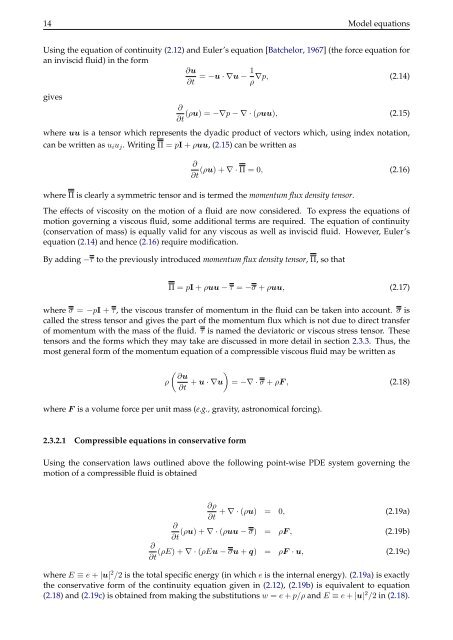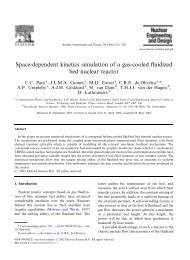Chapter 8 Configuring Fluidity - The Applied Modelling and ...
Chapter 8 Configuring Fluidity - The Applied Modelling and ...
Chapter 8 Configuring Fluidity - The Applied Modelling and ...
Create successful ePaper yourself
Turn your PDF publications into a flip-book with our unique Google optimized e-Paper software.
14 Model equations<br />
Using the equation of continuity (2.12) <strong>and</strong> Euler’s equation [Batchelor, 1967] (the force equation for<br />
an inviscid fluid) in the form<br />
gives<br />
∂u<br />
∂t<br />
1<br />
= −u · ∇u − ∇p, (2.14)<br />
ρ<br />
∂<br />
(ρu) = −∇p − ∇ · (ρuu), (2.15)<br />
∂t<br />
where uu is a tensor which represents the dyadic product of vectors which, using index notation,<br />
can be written as uiuj. Writing Π = pI + ρuu, (2.15) can be written as<br />
∂<br />
(ρu) + ∇ · Π = 0, (2.16)<br />
∂t<br />
where Π is clearly a symmetric tensor <strong>and</strong> is termed the momentum flux density tensor.<br />
<strong>The</strong> effects of viscosity on the motion of a fluid are now considered. To express the equations of<br />
motion governing a viscous fluid, some additional terms are required. <strong>The</strong> equation of continuity<br />
(conservation of mass) is equally valid for any viscous as well as inviscid fluid. However, Euler’s<br />
equation (2.14) <strong>and</strong> hence (2.16) require modification.<br />
By adding −τ to the previously introduced momentum flux density tensor, Π, so that<br />
Π = pI + ρuu − τ = −σ + ρuu, (2.17)<br />
where σ = −pI + τ, the viscous transfer of momentum in the fluid can be taken into account. σ is<br />
called the stress tensor <strong>and</strong> gives the part of the momentum flux which is not due to direct transfer<br />
of momentum with the mass of the fluid. τ is named the deviatoric or viscous stress tensor. <strong>The</strong>se<br />
tensors <strong>and</strong> the forms which they may take are discussed in more detail in section 2.3.3. Thus, the<br />
most general form of the momentum equation of a compressible viscous fluid may be written as<br />
� �<br />
∂u<br />
ρ + u · ∇u = −∇ · σ + ρF , (2.18)<br />
∂t<br />
where F is a volume force per unit mass (e.g., gravity, astronomical forcing).<br />
2.3.2.1 Compressible equations in conservative form<br />
Using the conservation laws outlined above the following point-wise PDE system governing the<br />
motion of a compressible fluid is obtained<br />
∂ρ<br />
+ ∇ · (ρu) = 0, (2.19a)<br />
∂t<br />
∂<br />
(ρu) + ∇ · (ρuu − σ) = ρF , (2.19b)<br />
∂t<br />
∂<br />
(ρE) + ∇ · (ρEu − σu + q) = ρF · u, (2.19c)<br />
∂t<br />
where E ≡ e + |u| 2 /2 is the total specific energy (in which e is the internal energy). (2.19a) is exactly<br />
the conservative form of the continuity equation given in (2.12), (2.19b) is equivalent to equation<br />
(2.18) <strong>and</strong> (2.19c) is obtained from making the substitutions w = e + p/ρ <strong>and</strong> E ≡ e + |u| 2 /2 in (2.18).




